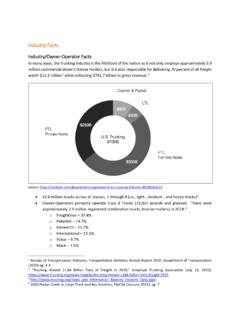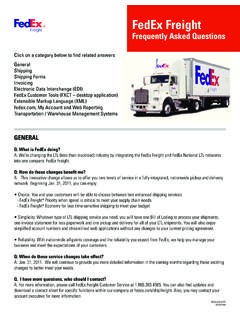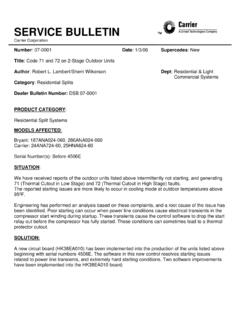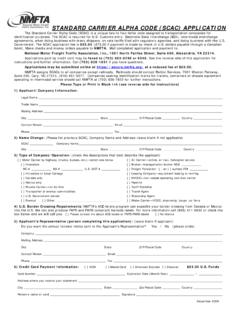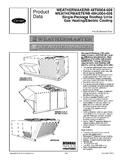Transcription of DEPARTMENT OF CALIFORNIA HIGHWAY PATROL M …
1 DEPARTMENT OF CALIFORNIA HIGHWAY PATROL . MODIFIED STATEMENT OF REASONS. AMEND ARTICLE 1, DEFINITIONS AND GENERAL PROVISIONS, SECTIONS 1200; ARTICLE , carrier IDENTIFICATION NUMBERS, SECTIONS , , AND ; AND ARTICLE 8, SECTION 1256, IDENTIFICATION. ADOPT NEW SECTION , LEASED VEHICLES. MOTOR carrier SAFETY. carrier IDENTIFICATION. (CHP-R-09-15). EXISTING REGULATIONS AND AMENDMENTS. CALIFORNIA Vehicle code (CVC) Section 34501 requires the DEPARTMENT of the CALIFORNIA HIGHWAY PATROL (CHP) to adopt reasonable rules and regulations which, in the judgment of the DEPARTMENT , are designed to promote the safe operation of vehicles described in CVC.
2 Section 34500. Those regulations are contained in Title 13, CALIFORNIA code of Regulations (13 CCR). CALIFORNIA Vehicle code Section requires certain persons, primarily motor carriers, to obtain a CALIFORNIA carrier Identification number , identified in regulation as a CA number , . from the CHP, and with some exceptions, to display that number on both sides of the vehicles mentioned above. During 2001/2002, in order to provide greater clarity to the enabling statute, the CHP adopted regulations relating to the assignment of carrier identification numbers.
3 Now, however, the CHP believes that recent developments indicate that all persons who are subject to CVC Section , should be provided greater clarity with regard to whom the CA number should be assigned. That clarity is provided through formal adoption of regulations in 13 CCR. Background The CHP promotes the safe operation of the vehicles listed in CVC Section 34500 by various means, one of which is by collecting information relating to the safety performance of the motor carriers who operate those vehicles.
4 Since the development of the Management Information System of Terminal Records (MISTER) in 1986, that information has been stored in an automated record system, which has been used by the CHP primarily as an internal tool to manage its motor carrier inspection workload. To ensure that information collected is attributed to the correct motor carrier in the records of the CHP, each record is identified with a CA number , and it is this CA number that CVC Section requires certain persons to obtain. While historically, the CA numbers were merely the means by which those records were identified; today, the CA number is far more relevant in identifying the responsible motor carrier entity.
5 For years, CA numbers were assigned without specific written rules and without a clear objective of identifying the person responsible for the actual motor carrier operations. Conversely, multiple motor carriers have sometimes shared the same CA number due to a lack of recognition in the CHP's records of their existence as separate legal entities. These errors typically occurred because of confusion with business relationships; such as the relationship between motor carriers and independent drivers contracted to drive vehicles leased by the motor carrier .
6 These drivers (independent contractors) were thought to be independent entities, when in fact they were private contractors operating vehicles leased and operated as part of a larger motor carrier operation. In other cases, two or more separate companies were mistakenly treated as a single company because of their close business relationship, when in fact they were separate legal entities. This matter was further complicated in 1997, when the Motor Carriers of Property Permit Act (the Act) was signed into law, which created a new class of motor carrier , the Motor carrier of Property (MCP).
7 Among other things, the Act required all MCPs to obtain a CA number from the CHP, and to register it with the DEPARTMENT of Motor Vehicles (DMV), the agency assigned responsibility for issuing the permits created by the Act. While, most MCPs, as defined in CVC Section 34601, are also motor carriers as defined in CVC Section 408, and were therefore already subject to CVC Section ; due to the separate definitions of those terms, there are some MCPs who are not also motor carriers pursuant to CVC Section 408.
8 The motor carrier definitions describe two groups that largely overlap one another, but there are many persons who fall into only one of the groups. This means that there are some persons who are subject to the requirement in CVC. Section to obtain and display a CA number solely because they are MCPs as defined in CVC Section 34601, even though they are not motor carriers as defined in CVC Section 408. Those persons must obtain a permit from the DMV to operate their vehicles on the HIGHWAY , but because they are not also motor carriers, they are not subject to the motor carrier safety regulations of the CHP.
9 For these reasons, among others, it is more important than ever to ensure greater clarity is added to the regulations in order to more clearly identify the motor carrier , whether defined by CVC Section 408, CVC Section 34601, or both. An applicant for a MCP permit obtains the permit to operate certain vehicles on the HIGHWAY by submitting an application and fee to the DMV and providing proof of adequate insurance as part of the process. The permit represents a privilege that can be suspended or revoked by the DMV.
10 Therefore, the CA number assigned by the CHP now has a dual role. First, it is an identification number that does not entitle the holder to any form of authority or permit to operate. Second, it is used as the unique identifier for an MCP permit in order to reduce the identifying numbers assigned to the motor carrier industry, and that permit does entitle its holder to operate certain vehicles on CALIFORNIA highways. In this second role, the CA number represents records that could become exhibits in proceedings to suspend or revoke the MCP permits of unsafe carriers, or of those that consistently fail to comply with applicable laws.
